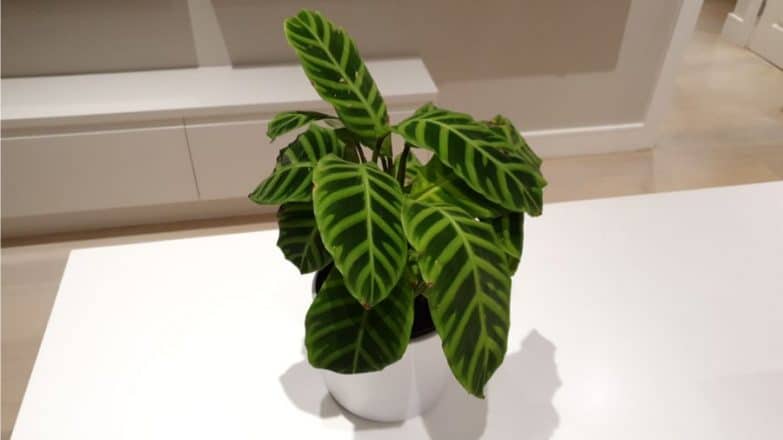Whether you are new to growing Calatheas or have a long-term relationship with these tropical beauties, you won’t be disappointed with the addition of Calathea zebrina, with its striking striped foliage. Although it can be a bit fussier than some houseplants, the eye-catching foliage is worth the effort. This article will help you maintain good Calathea zebrina care and keep your plant healthy and happy.
Calathea Zebrina Care Summary: To keep your Calathea zebrina healthy grow in fertile, well-drained soil and keep the soil lightly moist. Fertilize monthly through the growing season, situate in bright, filtered light where temperatures range between 65°F to 75°F and create humidity of >60% ideally.
Continue reading because we give you the lowdown on calathea zebrina care as well as solutions to all the common to keep it thriving for years to come.
Calathea Zebrina Care Guide
| Scientific Name | Calathea zebrina |
| Origin | Southeastern Brazil |
| Light Requirements | Bright or medium, indirect light. |
| Watering | Keep the soil lightly moist, watering once the top of the soil is just starting to dry out. Avoid soggy soil. You may see better results by using filtered water or rainwater. |
| Soil | Well draining potting mix. One part potting soil, two parts peat and two parts perlite is a good option. |
| Temperature | 65-75°F (18-24°C). |
| Fertilizer | Fertilize monthly with 1/4 strength water soluble fertilizer during the growing season. Avoid over-fertilizing and flush the soil several times per year. |
| Humidity | High humidity is very important to keep foliage looking well. >60% humidity where possible. |
| Pruning | Minimal pruning requirements. Remove dead or damaged foliage as required. |
| Propagation | Propagate by division |
| Re-Potting | Only repot when quite root bound, as doesn’t tolerate frequent re-potting. |
| Diseases and Pests | At risk of root rot if overwatered. Fairly pest-resistant, but can be affected by spider mites, aphids, mealybugs and scale at times. |
| Toxicity | Non-toxic to humans and animals. |
| Where To Buy | Buy Calathea zebrina online at Etsy (I buy most of my houseplants from Etsy). |
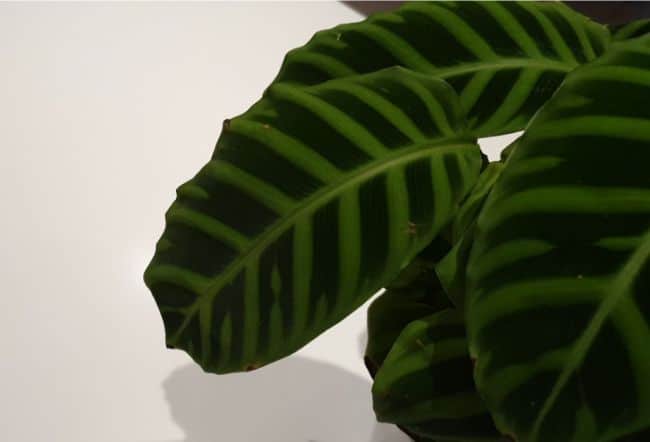
Characteristics And General Information
Native to warm and humid tropical rainforest regions of southeastern Brazil, Calathea zebrina is classified as an herbaceous perennial that will give you years of healthy growth when given proper care. The species belongs in the genus Calathea, along with several dozen other species and hundreds of cultivars.
Calatheas are members of the Marantaceae family, the same family as the close relative Prayer Plants, in the genus Maranta. You will find Calathea zebrina also listed under its new scientific name Goeppertia zebrina.
Calathea zebrina earns it common name Zebra Plant due to the striking light green and velvety leaves with purple undersides and having dark green stripes running across them resembling a Zebra.
Each leaf can grow over 12 inches tall and mature clumps of this tropical perennial can grow over 2 feet wide and tall. Like many species of Calathea and like its close relative Prayer Plants, Calathea zebrina’s leaves fold at night, adding even more interest to the attractive striped foliage.
Like all varieties of Calathea, Calathea zebrina only thrives in a consistently warm and humid year-round environment. Therefore, if you’ve set your potted Zebra Plant outdoors to give it a break from indoor growth or promote blooming, be sure to bring it back indoors before winter comes knocking on the door.
When grown indoors as a houseplant, Calathea zebrina rarely blooms. However, when Calathea zebrina does bloom, it forms small, inconspicuous white to purple flowers on upright stalks. Therefore, don’t be disappointed if your Zebra Plant never blooms because when it comes to this plant’s striking looks, it’s not about the flowers but the handsomely striped leaves.
Calathea zebrina is one of the more popular varieties of Calathea, so it’s probably easier to locate at your local plant nurseries and garden centers. However, don’t despair if you can’t locate one locally as there are multiple online plant growers selling Calathea zebrina.
Calathea zebrina works great as a houseplant, as well as being suitable plants to display in a large terrarium or a greenhouse. Wherever you decide to use it, it is sure to grab attention and add a feel of the tropics.
Calathea Zebrina Soil Requirements
In its native habitat, Calathea zebrina grows along the rainforest floor where the consistently moist soil is fertile with fallen leaves and other plant debris. When replicating this soil at home for your potted Zebra Plant, it’s best to use a fertile, peaty mixture with good drainage.
Although Calathea zebrina requires a moist soil medium, this doesn’t mean to use a heavy soil mixture that has a tendency to retain too much water for too long a period or rot can occur. On the other hand, you don’t want to use a fast-draining mix containing too much sand or you will have problems keeping the soil moist.
A mix of one part potting soil, two parts peat and two parts perlite is a good mix for Calathea zebrina. Many African violet mixes are also a good choice.
Check out my article about choosing and making potting soil to learn more.
Preferred Light Conditions
Even when grown outdoors in its preferred climate, Calathea zebrina plants prefer a shady to partially shady location. When grown as houseplants you should provide bright or medium, indirect light. Avoid direct sunlight, especially during the afternoon, which is the hottest portion of the day, or you may notice the foliage losing color or developing burns or brown patches or edges.
Although it tolerates lower light, if conditions are too dark your Calathea zebrina may lose its robust growth and produce leggy stems. If this happens, gradually move to a brighter location.
Temperature Requirements
Remember, Calathea zebrina is native to tropical areas where temperatures remain warm year-round. Grow in an indoor location where temperatures average between 65°F to 75°F. Additionally, you should avoid placing your Calathea zebrina in locations exposed to hot or cold drafts. Warm drafts may cause brown leaf edges or leaf curling and cold drafts can cause wilting and leaf yellowing.
Some people like to take their Calathea zebrina outside over the summer months, but you should make sure to bring it indoors again well before the cooler nights of autumn.
Water Requirements
One of the more challenging aspects of Calathea zebrina care is keeping the soil lightly moist but not too saturated. You don’t want waterlogged soil, but you shouldn’t allow it to completely dry out either. If the soil dries excessively, your plant will wilt and the leaves will curl. Try to avoid this happening, as recurrent stress such as this can really cause a calathea to struggle.
While the plant is actively growing, during the seasons of spring through summer, you will need to water more often to keep the soil moist. However, during winter, Calathea zebrina goes into dormancy and growth slows, resulting in reduced water requirements.
Assessing whether your Calathea zebrina needs water is more of an art than a science and there are so many factors that can impact the watering frequency. Read my guide to watering houseplants to get some tips on how to water your houseplants at exactly the right time.
How To Water Calathea Zebrina
When you decide it is time to water your Calathea zebrina, water thoroughly. This means adding water until it flows freely from the drainage holes and ensures the soil is fully and evenly saturated.
I always take my Calathea to the sink to water it, and let it drain for at least 5 minutes before returning it to its normal spot. This ensures the soil isn’t waterlogged, and prevents issues that can occur when you leave your plant sitting in a drip tray full of water for too long.
When it comes to the type of water you should use, some people suggest that room temperature water is better than cold water. The theory is that very cold water can stress your plant, so this may be something to consider if your Calathea zebrina is struggling a little.
Calathea zebrina, like most other calatheas can be very sensitive to water quality also. If you live in a hard water area, or your tap water has high levels of chlorine or fluoride, this can cause leaf spotting and brown leaf tips. Using filtered water or rainwater is a good option.
I collect rainwater to water all of my calatheas, although this is more as a precaution. Some people seem to use tap water without many issues.
Humidity Requirements
Another tricky element of Calathea zebrina care is fulfilling the plant’s high requirements for humidity. Without high humidity, the foliage will turn brown at the tips and edges, the leaves will curl and the plant will fail to thrive.
If your home does not naturally have humidity levels of >50%, and ideally >60%, you should definitely take steps to increase this to keep your Calathea zebrina healthy. You have several options from relatively maintenance-free to those that take a little bit of effort to give the Calathea the humidity it requires.
- Sit the Calathea zebrina on a tray filled with pebbles either alone or mixed with other plants. As the water in the pebble tray evaporates, humidity is created around the plant.
- Place the Calathea zebrina in a room where a humidifier is being used.
- If you have a natural humid room like the bathroom or kitchen where water is constantly used and has the needed light conditions, your Zebra Plant will grow well there.
- Group the Zebra Plant with other potted plants.
- Misting the plant with room temperature water several times weekly is also an option, but it is debatable how effective this is.
See my article about how to raise humidity levels for your houseplants for more detail.
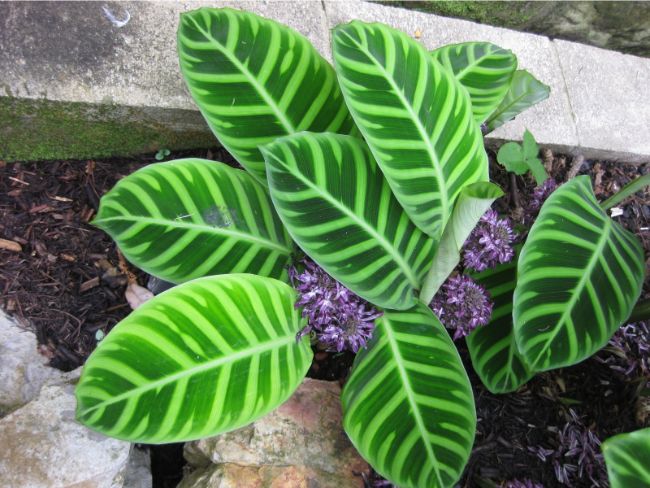
Fertilizer Requirements
Calathea zebrina has relatively low fertilizer requirements, but I find it does best when fertilized monthly with a very dilute, balanced fertilizer solution. I use a water soluble fertilizer that I make up at 1/4 strength. Here is what I’ve been using for the last few years with great success.
I prefer to err on the side of caution, as it is easy to over-fertilize, and this will generally cause more problems than underfertilizing. Don’t feed the Calathea during fall and winter as it stops active growth.
There are many suitable fertilizers for your Calathea zebrina, including both organic and synthetic options. Read my guide to fertilizing houseplants to see what your options are and how to fertilize your houseplants properly.
All types of Calatheas are susceptible to burns from a buildup of salts in the soil from the fertilizers. If your Calathea zebrina is otherwise receiving proper care and you notice the leaves developing brown patches, you should consider flushing the soil.
- Take your Calathea zebrina to the sink and allow the water to run slowly through the soil flushing out the salts. After about five minutes, turn off the water and allow the soil to fully drain and then empty any additional water from the catch tray and place back in its normally growing location.
You will probably only have to worry about flushing the soil several times yearly.
Pruning Needs
Calathea zebrina’s pruning requirements are low and the only trimming you will most likely have to worry about is snipping off any dead or dying foliage. If needed, you can also reduce the size of the plant by pruning off healthy stems and leaves. Additionally, you can trim off any brown leaf edges and it won’t affect the remainder of the leaf’s growth.
Always use sterilized pruning tool blades when doing any pruning to your Zebra Plant so you don’t transfer any possible disease to the plant. This is as easy as wiping the blades off with rubbing alcohol or a household disinfectant.
Planting Tips
Calathea zebrina plants don’t like being repotted too often. Unless you purchased your Calathea zebrina in a container it was already outgrowing, you probably won’t have to worry about repotting it for another year or two.
Once it starts outgrowing its present container you should repot it into another that is one size larger. When it comes to potting considerations:
- Repotting is best done in spring.
- Any container material works well as long as it drains from the bottom. However, those made of a porous material like terra cotta will allow the soil to dry out quicker that those made of plastic and require more frequent watering.
- Always use a rich potting mix with a peaty base that drains well.
- Repot the Calathea zebrina at the same depth it was originally growing, as planting too deep puts undue stress on the plant.
Steps for properly planting the Calathea zebrina are relatively basic:
- Fill the new container about a quarter full of the potting mix. Water the soil to settle it.
- Gently remove the Zebra Plant from its original container, being careful not to damage the roots or herbaceous leaves and stems.
- Place the Calathea in the new pot and fill the remainder of it with soil, being sure its planted at the same depth it was growing.
- Firm the soil around the plant’s base using your fingers and thoroughly water the soil again.
Once replanted, place the Calthea zebrina in an appropriate location. Take extra care to meet your plant’s care needs in the weeks after repotting, as the plant will need TLC to thrive through this stressful experience.
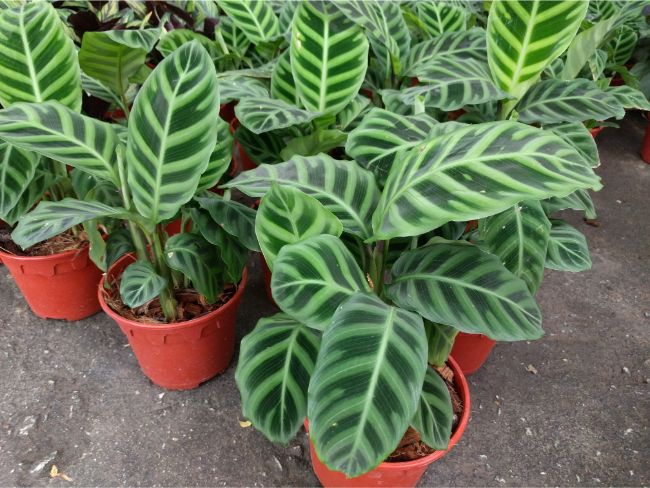
Propagation
The best way to propagate Calathea zebrina is by division in spring or early summer. Whilst not needing much technical skill, this aspect of Calathea zebrina care can be tricky as they are quite sensitive to this process. Dividing a plant that is growing too large for its existing pot is also a good option to maintain your plants size.
You will get additional plants by dividing the mature mother plant. Carefully remove the mother plant from its pot and gently divide the root system manually or with a sharp knife.
After you have divided the Calathea, repot it in a container with bottom drain holes and filled with a rich, peaty soil that drains well. Make sure to plant the divided section no deeper than it was originally growing and place back in the same environmental conditions it was originally growing.
Disease Problems
Calathea zebrina has no major disease problems other than root rot due to conditions that are too wet. Growing the plant in soil that retains too much water, poor drainage and repeated overwatering are the most likely culprits. Signs of a rot problem include:
- The bottom section of the Calathea zebrina turns mushy and develops black rotted sections.
- The edges and bottom of the foliage starts turning black.
- Root system is black leading to the entire plant collapsing and dying.
Prevention is key to eliminating potential root rot problems from developing. Make sure to grow the Zebra Plant in fertile soil that drains well, isn’t too heavy, and doesn’t remains soggy for long periods.
Additionally, although the plant grows best in soil that is moist, this doesn’t mean saturated in water. During the growing season, plan on watering weekly and maybe more to retain soil moistness. However, in winter while the plant is in dormancy, plan to water about every two weeks or so.
For more information, see my articles on how to fix an overwatered plant and how to identify, fix and prevent root rot.
Pest Problems
Like diseases, Calathea zebrina doesn’t have any serious pest problems but can sometimes be bothered by spider mites, aphids, mealybugs and scale. All of these pests are easily identified and controlled.
- Spider Mites: Small white insects that spin a find webbing over the plant. The insects suck the inner juices from the plant’s stems and leaves and can quickly damage the Calathea if left untreated.
- Aphids: Small pear-shaped insects that come in a host of colors and attach along the Calathea’s stems in masses. The insects suck the inner juices from the plant’s stems.
- Mealybugs: Mealybugs form into white cottony masses along the Calathea’s stems and the crotches of leaves. Like the other pests, they suck juices from the plant.
- Scale: Scale insects are small armor-like pests that form along the Calathea’s stems in masses. They suck the inner juices from the Calathea.
Controlling any insect problem as soon as you notice one is the best course of action in keeping your Calathea zebrina healthy and not having the pests migrate to your other houseplants.
Treat the problem with sprays like neem, insecticidal soap and in the event of a scales, horticultural oil for severe problems if regular insecticides don’t work. Follow instructions for the product’s mixing, use and frequency of additional applications. Always check to make sure the product is safe for using on Calatheas.
Additional Calathea Zebrina Care Questions
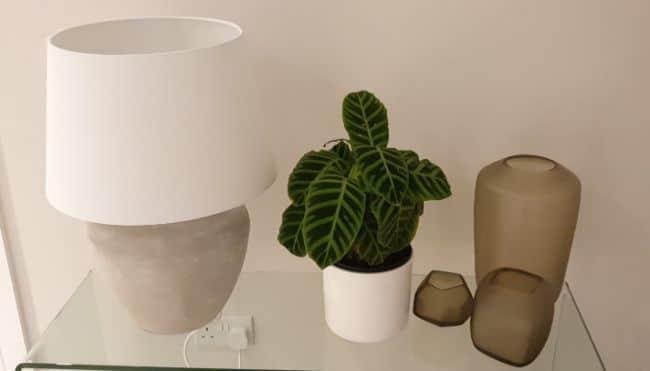
Why Are The Leaves On My Calathea Zebrina Turning Brown?
There are several reasons for the edges of your Calathea’s leaves to turn brown including, excess fertilizer, inadequate humidity, uneven watering and soil that is too dry. Don’t overfertilize and only feed the Calathea during the growing season of spring through summer using a water-soluble, liquid houseplant blend applied at 1/4 to 1/2 strength. It won’t hurt the leaf to trim off the brown sections.
Flush the soil ever to remove any salt build up that can also lead to brown foliage. Calathea zebrina prefers moist soil, so water regularly through the growing season to keep the soil consistently moist by not soggy.
You can increase humidity by placing the plant on a tray of pebbles, grouping it together with other plants, using a humidifier or growing in a room with natural humidity or misting the plant regularly with room temperature water.
Why Is My Calathea Zebrina Wilting?
If you notice your Calathea zebrina starting to wilt, it can be due to conditions that are too cold or not receiving enough water. Make sure the indoor temperatures are between 65°F to 80°F. Calatheas do not tolerate cold environments.
If cold air isn’t the problem, then check the soil for dryness because the plant probably isn’t receiving enough water to keep the soil consistently moist like Calatheas prefer. Feel the soil regularly and if it seems like it’s losing its moisture, give the plant a dose of water.
My Calathea’s Leaves Are Curling And Spotting
Leaf curl and leaf spots in Calathea zebrina are normally a sign of insufficient water, low humidity or there is an issue with water quality. Regularly feel the top of the soil for moistness and water if it’s starting to feel dry and lose its moisture content. Consider switching to filtered water or rainwater.
Is Calathea Zebrina Toxic To Pets?
Calathea zebrina is considered non-toxic to dogs and cats.
Does Calathea Zebrina Need Pruning?
The only time you need to do any pruning to your Calathea is to remove dead leaves, trim off brown sections or to control the plants size, if desired, and always using sterilized pruning tools to prevent disease problems.

